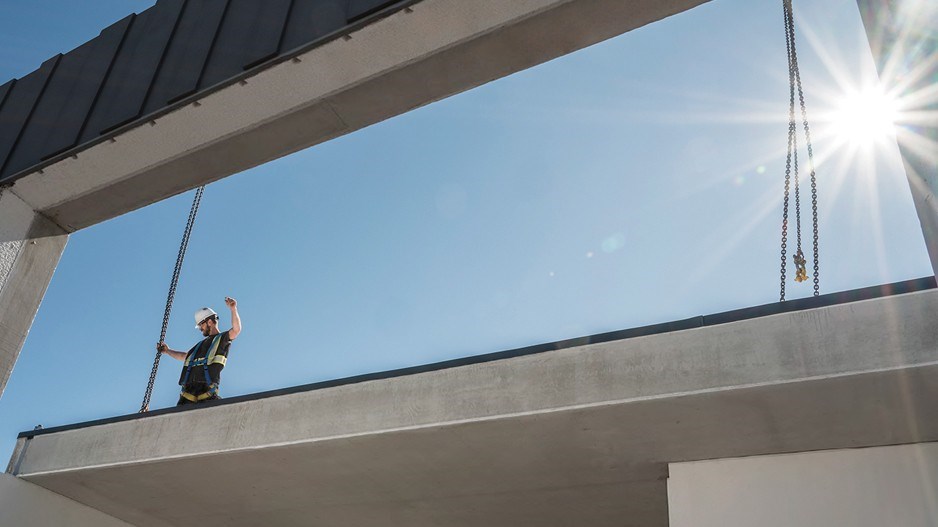Using conventional construction materials and methods, a new Starbucks (Nasdaq:SBUX) built in Abbotsford last year might have taken four to six months and dozens of construction trades people to build.
Using Nexii Building Solutions pre-fabricated building materials, it took four people six days to assemble the building shell.
“We can assemble a typical quick-serve restaurant in six to eight days with a crew of four to six people,” said Bill Tucker, CEO of Omicron, one of Vancouver’s biggest integrated building companies. “That’s the building shell.”
A new nine-storey Courtyard by Marriott hotel being built in Nanaimo will take a little longer – about two and a half months.
“It’s probably half the time that it would have taken us through a conventional build,” Tucker said.
Much of the attention that Nexii has received has been because of its sustainability angle and the company’s recent $1 billion valuation.
Nexii developed a polymer concrete that is resistant to fire, water and pests. It is also highly insulating and has a much lower embedded and operational carbon intensity compared with concrete and steel. Investors have been plowing millions in private equity into the company.
But for developers and builders, the big selling point may not be so much that Nexii’s proprietary Nexiite materials are greener than concrete and steel, but rather that the building methods involved result in shorter construction times and lower labour costs.
Buildings made from Nexiite are pre-fabricated at a local manufacturing plant and easily and quickly assembled at the construction site. It is an approach that promises to disrupt the construction industry in a very big way.
Omicron, a traditional integrated design, engineering and construction company, was one of Nexii’s early investors. It is now a wholly owned subsidiary of Nexii.
One of the things that attracted Omicron to Nexii is that the building sector is under pressure to lower its carbon intensities, and Nexite is a low-carbon alternative to carbon-intensive concrete and steel. The material has 20% to 40% less embedded carbon than concrete and steel. And because of its high insulating properties, it has up to 60% less operational carbon.
“Because our buildings are so highly insulated and tight, think of our building as a thermos or Yeti cooler,” said Nexii CEO Stephen Sidwell. “It only requires a fraction of the energy to operate the building.”
But another big selling point for Omicron was the lower labour requirements.
“For years we’ve been talking about making the industry more efficient,” Tucker said. “And with the great challenges we have on the climate front, we felt that it was really time to step up and do our part and be part of the solution. That’s why we were one of the first investors in Nexii – because we believed in it.”
Sidwell pointed out that the construction sector is facing a significant labour shortage.
“So we believe we’re providing a solution, where we can take existing people, reskill them to become Nexii certified, and we take a lot of that pressure off the shortage of labour.”
Nexii’s expertise is in manufacturing Nexiite, not construction, so the company decided it needed a partner with that expertise, and recently acquired Omicron.
“We need our own internal teams to thoroughly understand the Nexii building system so that we can then train the industry on how to do that,” Sidwell said. “So the acquisition allowed us to more than double our team very quickly with people who had been working together for decades.”
As for the impact on the construction trades, the construction worker of the future may be a carpenter who has been retrained to become a hybrid manufacturer-assembler, working first in a Nexii manufacturing plant making NeXite wall, floor and ceiling panels, and then going to the construction site to bolt them all together. That will require some new skills training.
“I think that we’ll start to see programs spring up,” Tucker said. “BCIT [the British Columbia Institute of Technology] and other technical universities will start to incorporate advanced manufacturing as part of their building technologies programs.”
The biggest market for Nexii buildings has been commercial buildings and mid-rises, though the company also sees opportunities in the residential sector. Because of the strength and weight that steel and concrete provide, Sidwell said NeXite can’t replace concrete and steel in highrises, although he added that NeXite panels could be used for exterior envelopes in highrises.
“That’s where we provide the airtight, energy efficient envelope,” he said.
Nexii’s business model is to build NeXite manufacturing plants in or close to cities where a lot of construction occurs to reduce the transportation emissions. Nexii has operating manufacturing plants in Moose Jaw, Saskatchewan, where the company was founded, and Squamish. More plants are being built or planned on Vancouver Island and in several U.S. cities, including Pittsburgh, Pennsylvania, where actor Michael Keaton is one of the investors in a new facility. •




